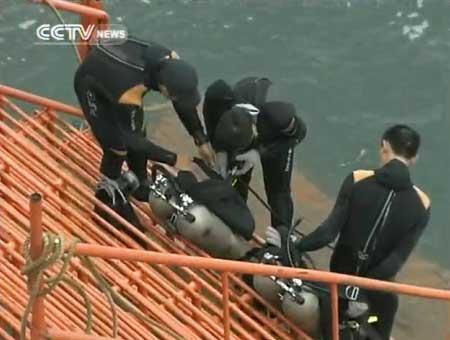Nan'ao One: Underwater archaeology lacks experts
The wreck of the Nan'ao 0ne is one of 200 underwater heritage sites in China. Despite its relatively late start, the field of underwater archaeology in China is making significant progress. But as Zhang Nini finds out, even with financial backing from the government, a lack of professional expertise is hampering advances.
Into the murky depths of the sea. China's archaeological teams are diving deep in search for past civilizations.
A group of twenty archaeologists are taking turns to plunge into the South China Sea, where they uncover troves of cultural artifacts from Nan'ao One, a Ming dynasty sunken vessel.

They are each equipped with a face mask which allows real time communication with the headquarters, underwater flashlights with a backup bulb; a knife to cut through fishnet trappings, a compass watch, and an underwater digital camera which relays back pictures of the mysterious sea. The high-profile salvage operation is provided with top notch technology, but according to team leader Cui Yong, the lack of talent has hampered its development.
Cui Yong, leader of Nan'ao One Archaeological Team, said, "The biggest problem is that we do not have enough underwater archaeologists. We are divided between several salvage projects. And each requires considerable time, money and personnel."
Archaeologists are making meticulous efforts to extract items from layers of silt. More than two thousand pieces have been retrieved this year. The porcelain wares were made in private kilns, and were on their way to Southeast Asia. The patterns of traditional wisdom embody an auspicious meaning.
Chen Huasha, a researcher from the Beijing Palace Museum, says underwater archaeology is not treasure hunting. It's a much more precise job aiming at reproducing a lost history.
Chen Huasha, National Committee of Cultural Relics, said, "Treasure hunters rob the items and are regardless of the damage they do to the ship. They are after a profit from these items. But archaeologists try their best to preserve every piece of history in the ship. They do their job little by little. So it's time consuming and costly."
According to preliminary surveys, China has more than 200 marine heritage sites, 70 of which are shipwrecks of great archaeological value. It is a rich cultural heritage lying in the deep, like exhibits in a giant underwater museum. And it's in dire need of thorough protection.
Illegal salvage is rampant in coastal provinces. The pillaging of underwater sites has become so common that sometimes archaeologists discover a site long after robbers have ransacked it.
Apart from personnel shortages, Professor Wu Chunming believes the implementation of existing laws regarding underwater heritage protection should be strengthened.
Prof. Wu Chunming, Dept. of History of Xiamen University, said, "China has a regulation over underwater heritage protection. But treasure hunting and the illegal sale of cultural relics is still a serious problem. For a systematic approach to underwater heritage protection, China has a long way to go."
But Wu's also confident. With sufficient material and monetary support from the government, China has made considerable headway in underwater archaeology in recent years. And he believes that the salvage of Nan'ao One will serve as an example for future projects underseas.

